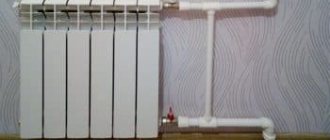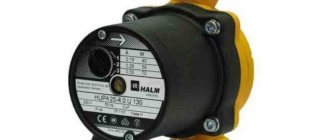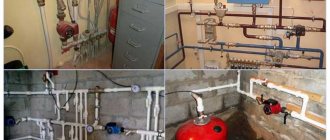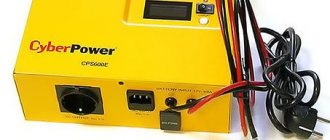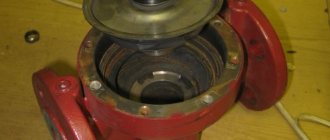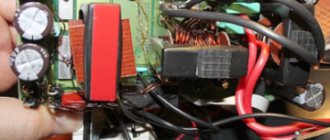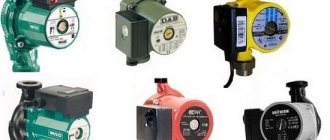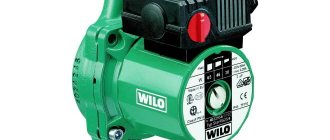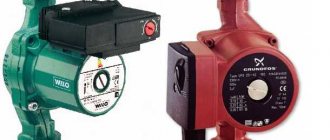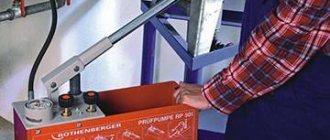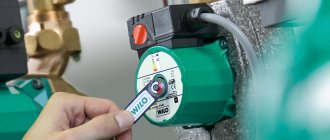Requirements for heating a house in winter is a must for a comfortable stay. To provide heating, a whole system of pipes and equipment is required to maintain constant pressure. One of these is a fluid supply pump.
Its function is to ensure constant pressure in the circulation system without changing the pressure in it. In fact, it provides efficient heating of rooms. Power is supplied from the network. At the same time, the pump allows you to use all the main parts of the heating system in private homes, and also significantly reduces the noise level.
Pump installation
Features of circulation pumps
In systems with a forced circulation system, a pump is installed to increase heat capacity. Correct installation of the circulation pump in the heating system allows you to change the heat that is transferred depending on the outside temperature while maintaining stability of the heating in the room.
There are two types of such equipment : with a dry and wet rotor. Devices with a dry rotor have increased efficiency (about 80%), do not create much noise and require constant maintenance. The operation of a device with a wet rotor is different; it has a low efficiency (about 50%), is noisier, and its performance is sufficient to heat any private home.
30 years ago, homes used so-called vertical central heating, which was powered by liquid circulating through pipes, and the heat source was a gas boiler or wood-burning stove. Now there has been a transition to the construction of private housing using heaters with a pump, which has the following advantages:
- The coolant speed increases.
- The heat produced by the boiler is quickly delivered to the radiators and returned to its place.
- The heating process is significantly accelerated.
- The speed is higher, so the same amount of heat can be supplied to pipes with a smaller diameter. In other words, a pipe with forced circulation of water in a pump is cheaper. The barrel can now be wrapped with minimal deflection and added complexity. The main thing is to make the correct selection of the pump unit and set the pressure.
- An internal pump for circulating water in the heating system made it possible to have heated floors and efficient closed systems operating under high pressure.
- We managed to remove the pipes that run along the walls and do not always harmonize with the kitchen interior. Nowadays, heating lines are built into the walls, under the floor and behind the suspended ceiling.
As the main disadvantage of the pumps, it can be noted that if there is a need to frequently turn off the circulation pump, a generator must be installed or connected.
Prevention and Maintenance
Long service life and trouble-free operation are possible only if proper operating conditions and regular maintenance of the pump are observed. Maintenance means periodic inspection and cleaning of the pump. Inspection for abnormalities in operation should be carried out at least once a quarter, that is, twice during the heating season. It is advisable to perform cleaning every two to three years, depending on the quality of the water and the conditions in which the pump operates.
During the entire period of operation, it is advisable to periodically check the operation of the pump:
- Connections are checked for leaks. If identified, gaskets and seals (tow, FUM tape, etc.) are replaced.
- The presence and condition of grounding is visually checked.
- The sound of a running engine should not be accompanied by clangs, knocks, or extraneous sounds.
- The engine should not vibrate much.
- The pressure in the line is checked and its compliance with the nominal one.
- The housing must be clean and dry. If this is not the case, then you should carry out external cleaning, check the electronic unit for flooding and eliminate the reason why the pump is wet.
Approximately every two to three years, it is advisable to clean the pump, including all its elements. This only applies to models that can be disassembled. There are pumps with a pressed or solid, welded casing that does not require repair or disassembly. Such units fail and are then replaced with a new assembly. It is advisable to entrust this work to a service center. However, if you have the skills and tools, you can do everything yourself
- hex wrench;
- slotted screwdriver (flat) 4 and 8 mm;
- Phillips screwdriver.
Device operation
Despite the large amount of information, many find it difficult to understand where and how to properly install a circulation pump to ensure forced circulation of water in the home heating system. You need to follow the instructions. Often this block is located on the return pipeline , which leads to the following situations:
- The temperature of the liquid in the supply is much higher, so the pump does not work.
- Hot water is less dense.
- The static pressure in the pipeline is higher, which facilitates the operation of the device.
Sometimes, when you get into a room where a boiler is installed that provides heating in the apartment, you can see that the system is based on return. We can say that this is the only correct solution, even if you don’t know about the centrifugal device that can be installed in the outlet pipe.
In an emergency and as a result of an increase in pressure, a safety valve is activated, which releases steam from the boiler. If the action is not completed, the valve allows pressure to be released, resulting in an explosion of the boiler shell.
Experience shows that no more than 5 minutes after the start of the heating process, the safety valve is activated. If you install the device on the return pipeline, steam will not appear in it, and the time before an accident will increase to 20 minutes. That is, if you install a check valve, you cannot prevent an explosion, but you can delay it in order to gain time to make a decision.
Boiler room maintenance cost
Technical (service) maintenance of the boiler room
| Name of works | Volume | Price |
| Service contract for floor-standing boiler (gas, diesel) up to 60 kW | with 1st scheduled departure | from 14 000 ₽ |
| Service contract for floor-standing boiler (gas, diesel) from 60 to 170 kW | with 1st scheduled departure | from 20 000 ₽ |
| Service contract for floor-standing boiler (gas, diesel) up to 60 kW | with 2 scheduled trips | from 22 000 ₽ |
| Service contract for floor-standing boiler (gas, diesel) from 60 to 170 kW | with 2 scheduled trips | from 30 000 ₽ |
| Service contract for wall-mounted gas boiler | with 1st scheduled departure | from 10 000 ₽ |
| Service contract for wall-mounted gas boiler | with 2 scheduled trips | from 15 000 ₽ |
| The exact cost is calculated after check-out | engineer |
Boiler room maintenance cost . Price adjusted as of May 05, 2021
Boiler room repair, diagnostics and prevention
| Name of works | Volume | Price |
| On-site inspection and diagnostics (without repair) | up to 50 km from MKAD | from 3,500 ₽ |
| On-site inspection and diagnostics (without repair) | from 50 to 100 km from MKAD | from 5,500 ₽ |
| Cleaning the burner (atmospheric) | power up to 60 kW | from 2,000 ₽ |
| Cleaning the burner (supercharged) | power up to 60 kW | from 3,500 ₽ |
| Cleaning the burner (atmospheric) | power from 60 to 170 kW | from 8,500 ₽ |
| Cleaning the boiler combustion chamber | power up to 60 kW | from 4,000 ₽ |
| Cleaning the boiler combustion chamber | power from 60 to 170 kW | from 6,000 ₽ |
| Checking and pumping up pressure in the expansion tank | without dismantling work | from 2,500 ₽ |
| Checking and pumping up pressure on the expansion tank | with dismantling and installation | from 4 500 ₽ |
| Refilling the heating system with a pump | system volume up to 200 liters | from 3 000 ₽ |
| Replacement of heating element, pump, heat exchanger, with coolant drain | for a unit | from 3 000 ₽ |
| Conversion of a gas boiler to liquefied gas | for a unit | from 3 000 ₽ |
| Burner settings | gas / diesel | from 2 500 ₽ |
| The exact cost is calculated after check-out | engineer |
Pump operating principle
Circulators operate on electricity. There are two approaches to the system, which leads to their division into “dry” and “wet” type devices. The principle of operation of a dry chain is that the drive is completely isolated from each pump and turbine, and rotation is transmitted through the shaft. As a rule, such devices are quite massive.
Dry pumps for circulating water in a heating system are powerful and efficient devices that provide very high flow rates and high pressure in the system. Without them it is difficult to control the heating. They must be installed in an apartment or private house. However, there are some disadvantages:
- The shaft that transmits rotation is a complex sealing system that prevents leakage of liquid under pressure. These seals gradually wear out, requiring regular preventive maintenance, including replacement with new ones.
- The operation of the pump is always accompanied by an air-cooled sound effect.
Finally, the system is a very expensive choice; the best option would be to purchase a wet rotor pump. The vertical wet rotor pump also comes in different types.
Rules for choosing a material to solve a problem
When the cause of the pipe damage has been established, it is necessary to look for acceptable repair methods. There are several of them. Only most are suitable for low water pressure in the water supply circuit or heating system.
If you don’t have such a device at hand, then any piece of rubber (for example, from a bicycle inner tube) and wire or something similar will do .
But other methods of eliminating leaks when it comes to heating or hot water supply systems are unlikely to work. Thus, often used cold welding and special sealants are not relevant for wet surfaces.
Other instantly hardening composites (epoxy resin, dichloroethane) are also excluded, since they can be used on dry and disconnected water supply routes.
A minor leak in the pipeline can be repaired on your own . But this will only be a temporary measure. At the end of the heating season, it is recommended to carry out major repairs so that the system no longer fails.
One-pipe and two-pipe systems
Experts distinguish between two heating schemes with forced circulation of the thermal agent - one-pipe and two-pipe. The choice of one or another option determines not only the location of the circuits, but also the length of the pipelines, as well as the type and quantity of equipment for shutdown, regulation and control.
A single-pipe heating system is characterized by the sequential inclusion of heating radiators in the circuit. The coolant returns through a separate pipeline to the boiler only after it turns one by one through all the devices of the system. The disadvantage of this method is that radiators that are closer to the thermal block become warmer than those further away, and this reduces thermal efficiency and equipment life. Introducing a circulation pump into the circuit and equalizing the temperature is achieved at all points of the system.
A two-pipe arrangement has advantages over a single-pipe arrangement, since all heating devices are connected in parallel to the supply and return lines, which promotes uniform temperature distribution throughout all rooms. Forced circulation of the refrigerant leads to increased efficiency of the system and the ability to regulate its thermal power.
Description and advantages of the technology
In the offer of the Italian company Baxi you can find various gas, electric and solid fuel heating boilers, which are intended for both small country houses and full-size country buildings. Such equipment is technologically advanced. It is efficient and economical, characterized by reliability and complete safety in operation.
The range of Baksi gas boilers has different capacities
The advantages of this brand’s equipment include:
- ease of maintenance of Baksi boilers;
- high degree of automation;
- affordable price;
- Possibility of choosing units of different power.
The Italian manufacturer produces equipment that can operate on various types of fuel, including pellets, wood, coal, electricity or natural gas.
You can choose both installations with a capacity of several kilowatts, which will be an excellent choice for a summer residence, and equipment that can quickly heat a house with an area of 200-300 square meters.
This video will help you get acquainted with the Baxi brand:
DIY installation
It is important to know how to properly install a heating pump. You also need to know which pump to install in the heating system. Each unit comes with instructions that you will study carefully to ensure you can complete the installation yourself correctly. All liquid is drained from the system, part of the pipe is cut off in the place where the pump is to be installed.
In many cases, an old system that has accumulated dirt and rust will need to be cleaned. It is inconvenient to do this through the drain valve due to the small cross-section of the hole, so use the cut point. A hose is connected to one side through which water is fed under pressure, and on the other side the water flows out.
Installation instructions
So, we will describe the installation stages when circulation pumps are installed on the bypass. This scheme is used most often and is recommended by experts due to the following advantages:
- quick, convenient dismantling;
- convenient temporary shutdown.
For wet options, a horizontal, level position is critical:
There are various modifications of already assembled bypass loops on the market: for welding, for flanges, with segments for shut-off elements.
If it is not advisable to buy a ready-made assembly, for example, when all the parts are in stock or if there are specific features of the location, then the bypass piping is made from scratch. But you will need skills in working with pipes (welding, thread cutting).
A good, recommended location is between the membrane tank and the boiler. Below is a universal option: for open/closed circuits, for connecting using the collector method (several pumps).
Assembly order
Diagram showing the movement of water, please note: shut-off valves are mandatory - when removing the device for repair or maintenance, they are turned off:
They start by assembling a unit (module) with taps: one per inlet/outlet. pump, the third is part of the lower straight pipe. It is necessary to carefully measure the return segment in order to accurately weld the segment with the shut-off fittings.
The bypass section from the central station is assembled. The nuts are only screwed on, tightening is postponed until the final stage. The top is the pump part (in the photo below the GRUNDFOS UPS pump) with two already screwed in taps, a filter, at the ends of the module there are small sections of pipe with threads like squeegees, they serve as material for welding. Below is a shut-off valve for the supply pipe (main).
They try on a bypass loop, mark the welding points on the pipe, use a drill with special drills to make a hole for the diameter of the section being mounted, and weld the joint.
They cut in the entire assembly with the lower shut-off valve on the main pipe, in our case, on the supply from the gas boiler:
The last step is to connect the pump to power.
Connecting the pump to power
So, the system is completely assembled, the pump is selected, installed, and then the device is connected to the power supply. Before the procedure, the entire line is completely de-energized—the machine is turned off on the panel. The device may have a plug for a socket or without it - just wires of a certain length for connecting directly to the home network on the panel.
Procedure: The pump wires are connected, taking into account the polarity, to the line. The terminals are labeled and have standard colors. If the device does not have a cable with a plug for a socket and you decide to use just such a connection, then you can buy it in any store, you will need a three-core cable, usually a cross-section of 2.5 mm² is more than enough.
It is highly desirable to have grounding (three-wire wiring), since proximity to water creates a significant risk of current entering the equipment elements. It is recommended to connect the device via an uninterruptible power supply (UPS); you can also connect a boiler to it.
An excellent solution is to insert a thermostat into the system (see diagram below), it can also be immediately included in the unit, which will automatically switch off when the coolant temperature drops below the set limits.
It is also highly advisable to install the device with a connection to the network through a difavtomat (its analogue of an RCD + AB) or through the boiler automation system, on which all these measures should be taken by default. And also, if there is an automatic protective device on any line with an outlet and the pump is not too powerful, for example, 90 W, that is, it will withstand all the consumers hung on it, then separate individual wiring with RCBOs and RCDs under the pump may not be installed. The device can be connected to such an outlet and not bother.
Connections without grounding are allowed, for example, when the house is old with two-wire wiring, but then the presence of a difavtomat or RCD+AV in the diagram is vital.
Filter installation
In order for the pump to work more reliably and longer, the coolant passing through it must be absolutely clean. Otherwise, the bearings and impeller may simply be destroyed by foreign objects entering them. The dirt filter, which is installed in front of it during the cooling process, captures all contaminants, sand and other small abrasive particles that appear in the system. Filters can always be changed .
As a dirt filter, you can use a regular coarse filter used in a water supply system. This is a small piece of pipe with an external dirt trap.
The straight cut has a metal structure that cuts out debris that could damage equipment. All debris should settle in the pipe, which can be periodically cleaned by unscrewing the plug at its end. Clogging must not be allowed.
The efficient functioning of the heating system in a cottage or country house is impossible without a circulation pump. Its uninterrupted operation guarantees that residents will be comfortable indoors during the cold season.
Circulation pump in the heating system
A heating circulation pump is considered reliable equipment that is easy to maintain. By following operating rules and performing timely preventive maintenance, you can minimize the likelihood of malfunctions. If malfunctions do occur, most of them do not pose a problem even for a technician with little experience. Repairing a heating circulation pump with your own hands is not difficult; it is enough to have general knowledge about the design of such equipment.
Installation diagrams in various types of systems
To begin with, let’s clarify the place where to install the flow pump, which circulates water through the boiler and forcibly directs it to the radiators of the heating system. According to our expert Vladimir Sukhorukov, whose experience is trustworthy, the installation location must be chosen in such a way that the unit is convenient to maintain. On the supply side it should be located after the safety group and shut-off valves, as shown in the installation diagram:
In order for the unit to be removed and serviced, shut-off valves must be installed on the sides
On the return line, the pump must be placed directly in front of the heat generator, and in tandem with a filter - a mud trap, so that you do not have to buy and install extra taps. The wiring diagram for the pumping unit looks like this:
When installing on the return line, it is better to place the mud collector in front of the pump unit
Recommendation. A circulation pump can be installed in this way in both a closed and an open heating system, there is not much difference. The statement also applies to the collector system, where the coolant moves to the radiators through separate connections connected to the distribution comb.
A separate issue is an open heating system with a circulation pump, capable of operating in 2 modes - forced and gravity. The latter is useful for homes where power outages often occur, and the owners’ income does not allow them to buy an uninterruptible power supply unit or a generator. Then the device with shut-off valves must be installed on the bypass, and a tap must be inserted into a straight line, as shown in the diagram:
This scheme can operate in forced and gravity mode
Important point. On sale there are ready-made bypass units with a pump, where instead of a tap on the flow there is a check valve. Such a solution cannot be called correct, since a spring-type check valve creates a resistance of the order of 0.08-0.1 Bar, which is too much for a gravity heating system. Instead, you can use a petal valve, but it must be installed only in a horizontal position.
Finally, we will explain how to install and connect a circulation pump to a boiler that burns solid fuel. As mentioned above, it is better to place the unit on the line coming from the heating system to the heat generator, as shown in the diagram:
As you can see, the piping uses a pump connection to the boiler circulation circuit with a bypass and a three-way mixing valve. The important role of these piping elements is described in detail in the manual on connecting solid fuel boilers.
Dry and wet rotors
Units in which the rotor does not come into contact with the liquid during operation are usually called “dry”. They are able to withstand high loads. The main problem with models with this design is that their O-rings quickly become unusable. Although these parts are designed to operate for 3 years, they quite often fail long before the specified time.
The reason for rapid destruction is usually impurities, which are always present in one quantity or another in the coolant. Particles contained in the air around the boiler can also have a negative impact.
If the tightness of the device is broken, this will inevitably lead to a short circuit. Electrical elements fail, and repairing the circulation pump with your own hands in the event of such breakdowns is already extremely difficult, if not impossible.
Units with a “wet” type of rotor, for example, such as pumps from the German brand Vilo, are much more often used for domestic purposes. They are designed using a modular principle, and therefore are more reliable, easier to maintain and more repairable.
Important! If you carefully ensure that a working device does not operate “dry,” then the equipment will not fail for a long time.
Models of pumps with a “wet” rotor
Note! When purchasing a circulation pump, you need to check whether it can be repaired and whether the manufacturer supplies spare parts for this brand of equipment.
Repair
It is best to take a broken circulation pump to a specialized service center, especially if it is still under warranty. Most of the models currently on the market, unfortunately, are non-separable or partially disassembled, so if problems arise with its internal spare parts, entire units or the pump assembly must be replaced. If the warranty period has already expired, and the design of the pump allows you to disassemble it and get to all the main components, then, if you have the appropriate skills, you can carry out the repair yourself.
Having determined the cause of the malfunction from the table above, it is enough to disassemble the pump, as indicated in the paragraph on prevention and maintenance, and replace the faulty part.
The main elements in the pump control unit are:
- 1-5 microfarad capacitor;
- terminal block for connection;
- speed controller.
Due to the small capacitance of the capacitor, you can check it using a multimeter, which has a built-in C-meter with a limit of up to 20 µF. If the readings deviate significantly from the nominal value, the capacitor should be replaced; it is important to maintain the polarity of the connection and be sure to have its voltage tolerance. For a conventional single-phase motor, capacitors with a tolerance of up to 450 V are used.
The speed controller assembly is replaced with a new one. It is enough to disconnect it from the terminals, remembering the position of each pin and connect a new one.
Popular models of circulation pumps are from the manufacturers Wilo, Ggrundfos, Dab. Not least due to their reliability. You can expect these pumps to break down within the warranty period only if the recommended operating conditions are violated. However, during the post-warranty period, Wilo often has problems with support bearings. Only replacing them helps.
Ggrundfos and Dab can “please” the impeller to become overgrown with scale for high-temperature heating systems, as well as silting of the stator cup. It is better to prevent these problems by installing a good filter and preparing the water. Otherwise, breakdowns are often justified by external problems.
Source of the article: https://udobnovdome.ru/obsluzhivanie-i-remont-cirkulyacionnogo-nasosa/
Heating circulation pump: device
Owners of private houses usually give preference to economical, low-power pumps with a “wet” type rotor.
The operating principle of this unit is simple: the impeller, rigidly fixed to the electric motor shaft, rotates and draws in the coolant coming from the inlet pipe. Then, under pressure, it pushes it into the discharge pipe, thus ensuring circulation.
If we disassemble the pump with our own hands, we must have a good understanding of its structure.
Diagram of a circulation pump with a “wet” rotor
Important! It must be taken into account that in “dry” type models, the rotor and drive motor are separated into a separate unit, and the rotation is transmitted to the impeller using a clutch.
How to disassemble a circulation pump
Disassembling the circulation pump is carried out only after the device is disconnected from the network. The taps mounted at the inlet and outlet are closed to prevent water from entering the device. In some cases, it is removed from the pipeline by shutting off the bypass and connecting a backup pump. The heating system continues to function normally, and the technician can deal with the breakdown without haste.
Let's look at how to disassemble a water pump using the example of repairing a Wilo circulation pump.
First, remove the terminal box cover. To do this, unscrew the screw on which it is attached.
Inspect the contents of the box. How to check if the starting capacitors are working? They are called using a tester.
The performance of starting capacitors is checked using a tester
At the next stage, the “snail” is removed. Unscrew two screws located diagonally and separate the element from the electrical part of the pump (rotor and stator).
The internal surface of the dismantled device is inspected for the presence of deposits that form due to poor water quality. The rotor cartridge is picked up with a screwdriver and pulled out of the housing.
Disassembly of the pump is completed, access to all parts located inside the pump is provided. Now the parts of the device can be carefully inspected and cleaned. The modular design allows you to reduce repairs to replacing a failed unit.
Troubleshooting
Based on how the pump operates, sound, vibration or changes in pressure, outlet pressure, it is necessary to accurately determine the malfunction and eliminate the cause.
| Symptom of malfunction | Probable Cause | Repair |
| The pump makes sounds after switching on, but the shaft does not rotate | Shaft oxidation due to prolonged inactivity | Unscrew the protective cap from the end of the shaft on the motor housing and manually turn the motor shaft using a slotted screwdriver. |
| Blocking by a foreign object | Disassemble the pump block with the impeller and clean it, check the condition of the coarse filter installed in front of the pump | |
| Power problems | Check the voltage rating in the network and correct the problem if necessary. | |
| After applying voltage, the pump does not start and does not make any sounds. | No actual voltage on power line | Check the power line and the condition of the circuit breakers |
| The fuse in the control unit has tripped | Replace fuse | |
| The pump turns off after a short period of operation | Limescale deposits in the stator cup | Clean the stator cup and motor rotor |
| Strong extraneous noise when the pump is running | Dry running, presence of air in pipes | Release the air. Drain the pump shell and fill with water. |
| Cavitation | Increase the pressure in the supply line. | |
| Pump vibration | Support bearing wear | Replacing bearings |
| Reduction of pressure and flow in comparison with the passport data | Abnormality in the power supply to the pump, phase change, resulting in a decrease in pump power or a change in the direction of rotation of the impeller | For three-phase motors, the quality of all phases is checked. For single-phase power supply, check the capacitor and replace if necessary |
| High hydraulic resistance of the circulation circuit | Check the filters, increase the cross-section of the pipes, check the condition of the shut-off valves. | |
| Triggering of external protection on the pump power line | Problems with the electrical part of the pump | Check the condition of the terminals for short circuits, check the capacitor and the control unit. Check the stator windings. Their resistance should not be lower than the rated value. |
Causes of circulation pump malfunctions
There are many reasons why the circulation pump may not work. For example, the presence of a large amount of suspended matter in the coolant can lead to malfunctions of circulation pumps. Small particles are deposited on the surface of the rotor, reducing the distance between it and the glass. Because of this, jamming occurs, leading to overheating and short circuit of the windings.
Wear and tear of the unit, operation in an unacceptable mode and a number of other factors lead to the need to replace some piece of equipment.
In cases of typical breakdowns, it is not difficult to repair the heating pump yourself. You can identify such problems by knowing their characteristic signs. This does not even always require disassembling the pump.
The pump works but vibrates a lot
There are only 2 reasons for this:
- The rotor has somehow shifted from its normal axis of rotation;
- The working shaft bearing is worn out.
The problem is solved by replacing the bearing (if possible) or replacing the pump.
Common problems
For what reason might the circulation pump not work? Owners of electric heating pumps most often encounter the following problems:
- the shaft does not rotate;
- the device vibrates too much;
- pump operation is accompanied by uncharacteristic sounds or excessive noise;
- the equipment heats up;
- coolant pressure is below the standard value;
- The unit suddenly switches off.
Let's look at each of these situations in more detail.
Shaft blocking is determined by the following signs: after switching on, the pump hums, but the impeller remains motionless. This usually happens after a long period of equipment downtime due to oxidation of the shaft surface.
Inner surface of the circulation pump housing
Vibration of the device in most cases is caused by the fact that the bearing that ensures the rotation of the impeller blades has worn out. The noise may be caused by a clogged filter. Sounds uncharacteristic of pump operation are also a sign that there is air in the system.
A discrepancy between the coolant pressure and the standard value can be caused by a number of factors: violation of instructions when connecting a three-phase device; clogged filter on the suction line; increased viscosity of the coolant.
Heating occurs in cases where the pump operates in an unusual mode with a significant excess of the permissible load.
The pump in the heating system turns off some time after it starts working due to scale and deposits that accumulate on the inner surface of the stator. Incorrectly connected wires and oxidized fuse contacts can also cause malfunctions.
Correct operation
A number of simple requirements apply to any circulation pump:
- Do not allow the pump to idle in the absence of water. Applies to both wet and dry pump types.
- The pump should not be allowed to operate with the water flow stopped, for example, if the valve before or after the pump is closed.
- The optimal operating mode should be determined taking into account the maximum and minimum throughput of the equipment.
- It is important to comply with the manufacturer’s requirements for the nominal water pressure in the system.
- The coolant temperature should not exceed 65°C. Therefore, the circulation pump is installed on the return line in front of the boiler, where the cooled water flows. When a given threshold is exceeded, the process of deposition of hardness salts on the internal surfaces of the pump accelerates many times over.
- Long periods of downtime should not be allowed. About once every month or two, it is advisable to turn on the pump for 15 minutes. If this is not done, then the risk of shaft jamming increases during the oxidation process.
- It is unacceptable to use a circulation pump to pump dirty water containing dense particles in suspension. A coarse filter must be installed, or the purity of the water or coolant is monitored in other ways.
In operating mode, the pump must have a uniform sound of the operating drive and a constant output pressure value, which is monitored by an installed pressure gauge. If handled well, even the simplest circulation pump can operate for up to 5 years until its main elements wear out.
Troubleshooting Methods
The ability to avoid going to a workshop to repair the circulation pump will save money and time. But only if the owner of the device is able to determine the cause of the breakdown himself and knows how to disassemble the pump and replace the faulty part.
Our recommendations are designed to resolve simple problems. Attempts to repair the pump with your own hands in the event of a serious breakdown that requires qualified intervention can permanently damage the equipment.
Attention! The engine can only be dismantled after turning off the power supply and draining the water from the unit.
Shaft blocked
Dismantle the engine and inspect the shaft surface. If it has oxidized, then the shaft should be turned by pressing the screwdriver against the special notch of the rotor.
The body vibrates
To stop strong vibration, replace the bearings. The worn part is removed, and a new bearing is carefully driven into the seat using a wooden hammer. The size of the spare part can be clarified in the technical documentation supplied with the device.
The pump is noisy
The metal mesh mounted at the inlet of the pump is pulled out and thoroughly washed under running water. Then, without turning on the device, open the taps. Find a nut on the body designed to bleed air and unscrew it. After the excess air has been bled off and water has flowed out, the nut is tightened.
Attention! For uninterrupted operation of the system, it is necessary that air is removed in a timely manner in each area. It is recommended to install air vents that will perform this task automatically.
Removing air from the circulation pump
Weak pressure
In a three-phase pump, the first thing to check is whether the phases are connected correctly. If the rotation of the blades is performed in the desired direction, then pay attention to the cleanliness of the filter. The clogged filter is pulled out and washed.
Pump casing heating
The problem can be eliminated if you follow the operating rules of the device and do not exceed the maximum load specified in the documentation.
Switching off the unit after starting
Lime deposits that impede the movement of the shaft are removed. If the surface is clean, then check whether the phase wires are connected correctly. Oxidized contacts are cleaned.
Prevention of circulation pump breakdowns
The equipment must be prepared in advance for intensive use during the cold season. Emergency repair of a heating circulation pump can cause a lot of inconvenience and lead to unplanned expenses. Prevention, to some extent, is a guarantee that the system will not fail at the most inopportune moment.
The pump in the heating system circulates the coolant
Careful owners perform the following activities before the onset of cold weather:
- check whether the device is installed correctly;
- renew the lubricant on the pipes and gaskets of the pump;
- clean the filter of the suction pipe;
- check how tight the connecting nodes are;
- Using a tester, they evaluate whether the device is correctly connected to the electrical network.
It is also necessary to conduct a test run to ensure that the equipment is working properly.
Owners of a house with autonomous heating need basic knowledge about the design and operating principle of circulation pumps. Any signs that the device is operating abnormally should not be ignored. After all, breakdowns in most cases are caused by improper operation. In order for the pump to function without failures, it is enough to regularly monitor the system throughout the heating season and carry out the necessary preventive maintenance.
Preparing the pump for the heating season
To ensure that your heating system does not fail during the winter, it is necessary to check the operation of the entire system, and in particular the circulation pump, before the start of the heating season.
It is necessary to check the serviceability of the device:
- There should always be lubricant on the gasket and pipes. If it has dried out, then it is necessary to lubricate the elements again; It is necessary to check the mesh filter. It often becomes dirty and interferes with the normal operation of the pump. If you notice blockages, you need to clear them;
- The circulation pump must be connected to the pipelines correctly. The best installation option would be in front of the heating boiler. With this arrangement, the formation of air pockets is minimized;
- The correct connection of heating equipment to the network can be checked with a special tester;
- Before the start of the heating season, it is necessary to check the operation of the pump. You can perform a test run.
